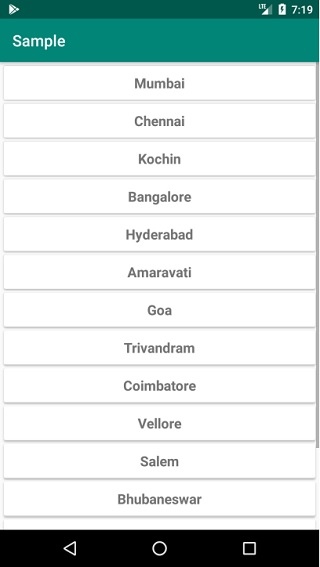
 Data Structure
Data Structure Networking
Networking RDBMS
RDBMS Operating System
Operating System Java
Java MS Excel
MS Excel iOS
iOS HTML
HTML CSS
CSS Android
Android Python
Python C Programming
C Programming C++
C++ C#
C# MongoDB
MongoDB MySQL
MySQL Javascript
Javascript PHP
PHP
- Selected Reading
- UPSC IAS Exams Notes
- Developer's Best Practices
- Questions and Answers
- Effective Resume Writing
- HR Interview Questions
- Computer Glossary
- Who is Who
How ListView's recycling mechanism works on Android?
This example demonstrates how ListView's recycling mechanism works on Android.
Step 1 − Create a new project in Android Studio, go to File ⇒ New Project and fill all required details to create a new project.
Step 2 − Add the following code to res/layout/activity_main.xml.
<?xml version="1.0" encoding="utf-8"?> <LinearLayout xmlns:android="http://schemas.android.com/apk/res/android" xmlns:app="http://schemas.android.com/apk/res-auto" xmlns:tools="http://schemas.android.com/tools" android:layout_width="match_parent" android:layout_height="match_parent" tools:context=".MainActivity"> <androidx.recyclerview.widget.RecyclerView android:id="@+id/card_recycler_view" android:scrollbars="vertical" android:layout_width="match_parent" android:layout_height="match_parent"/> </LinearLayout>
Step 3 − Add the following code to res/layout/card_row.xml.
<?xml version="1.0" encoding="utf-8"?> <androidx.cardview.widget.CardView xmlns:android="http://schemas.android.com/apk/res/android" android:orientation="vertical" android:layout_width="match_parent" android:layout_height="wrap_content" android:id="@+id/card" android:layout_marginTop="5dp" android:layout_marginLeft="5dp" android:layout_marginRight="5dp"> <TextView android:id="@+id/tv_country" android:layout_marginTop="10dp" android:layout_marginBottom="10dp" android:layout_gravity="center" android:textSize="18sp" android:layout_width="wrap_content" android:layout_height="wrap_content" android:textStyle="bold" /> </androidx.cardview.widget.CardView>
Step 4 − Add the following code to src/MainActivity.java
package com.app.sample; import android.os.Bundle; import android.view.GestureDetector; import android.view.MotionEvent; import android.view.View; import android.widget.Toast; import androidx.appcompat.app.AppCompatActivity; import androidx.recyclerview.widget.LinearLayoutManager; import androidx.recyclerview.widget.RecyclerView; import java.util.ArrayList; public class MainActivity extends AppCompatActivity { private ArrayList cities; @Override protected void onCreate(Bundle savedInstanceState) { super.onCreate(savedInstanceState); setContentView(R.layout.activity_main); initViews(); } private void initViews(){ RecyclerView recyclerView = (RecyclerView)findViewById(R.id.card_recycler_view); recyclerView.setHasFixedSize(true); RecyclerView.LayoutManager layoutManager = new LinearLayoutManager(getApplicationContext()); recyclerView.setLayoutManager(layoutManager); cities = new ArrayList<>(); cities.add("Mumbai"); cities.add("Chennai"); cities.add("Kochin"); cities.add("Bangalore"); cities.add("Hyderabad"); cities.add("Amaravati"); cities.add("Goa"); cities.add("Trivandram"); cities.add("Coimbatore"); cities.add("Vellore"); cities.add("Salem"); cities.add("Bhubaneswar"); cities.add(""); cities.add("Cuttack"); cities.add("Mysore"); RecyclerView.Adapter adapter = new DataAdapter(cities); recyclerView.setAdapter(adapter); recyclerView.addOnItemTouchListener(new RecyclerView.OnItemTouchListener() { GestureDetector gestureDetector = new GestureDetector(getApplicationContext(), new GestureDetector.SimpleOnGestureListener(){ @Override public boolean onSingleTapUp(MotionEvent e) { return true; } }); @Override public boolean onInterceptTouchEvent(RecyclerView rv, MotionEvent e) { View child = rv.findChildViewUnder(e.getX(), e.getY()); if(child != null && gestureDetector.onTouchEvent(e)) { int position = rv.getChildAdapterPosition(child); Toast.makeText(getApplicationContext(), (Integer) cities.get(position), Toast.LENGTH_SHORT).show(); } return false; } @Override public void onTouchEvent(RecyclerView rv, MotionEvent e) { } @Override public void onRequestDisallowInterceptTouchEvent(boolean disallowIntercept) { } }); } } Step 5 − Add the following code to src/DataAdapter.java
package com.app.sample; import android.view.LayoutInflater; import android.view.View; import android.view.ViewGroup; import android.widget.TextView; import androidx.recyclerview.widget.RecyclerView; import java.util.ArrayList; public class DataAdapter extends RecyclerView.Adapter<DataAdapter.ViewHolder>{ private ArrayList<String> cities; public DataAdapter(ArrayList<String> countries) { this.cities = countries; } @Override public DataAdapter.ViewHolder onCreateViewHolder(ViewGroup viewGroup, int i) { View view = LayoutInflater.from(viewGroup.getContext()).inflate(R.layout.card_row, viewGroup, false); return new ViewHolder(view); } @Override public void onBindViewHolder(DataAdapter.ViewHolder viewHolder, int i) { viewHolder.tv_country.setText(cities.get(i)); } @Override public int getItemCount() { return cities.size(); } public class ViewHolder extends RecyclerView.ViewHolder{ private TextView tv_country; public ViewHolder(View view) { super(view); tv_country = (TextView)view.findViewById(R.id.tv_country); } } } Step 6 − Add the following code to Manifests/AndroidManifest.xml
<?xml version="1.0" encoding="utf-8"?> <manifest xmlns:android="http://schemas.android.com/apk/res/android" package="com.app.sample"> <application android:allowBackup="true" android:icon="@mipmap/ic_launcher" android:label="@string/app_name" android:roundIcon="@mipmap/ic_launcher_round" android:supportsRtl="true" android:theme="@style/AppTheme"> <activity android:name=".MainActivity"> <intent-filter> <action android:name="android.intent.action.MAIN" /> <category android:name="android.intent.category.LAUNCHER" /> </intent-filter> </activity> </application> </manifest>
Let's try to run your application. I assume you have connected your actual Android Mobile device with your computer. To run the app from the android studio, open one of your project's activity files and click Run ![]() icon from the toolbar. Select your mobile device as an option and then check your mobile device which will display your default screen −
icon from the toolbar. Select your mobile device as an option and then check your mobile device which will display your default screen −

Click here to download the project code.

